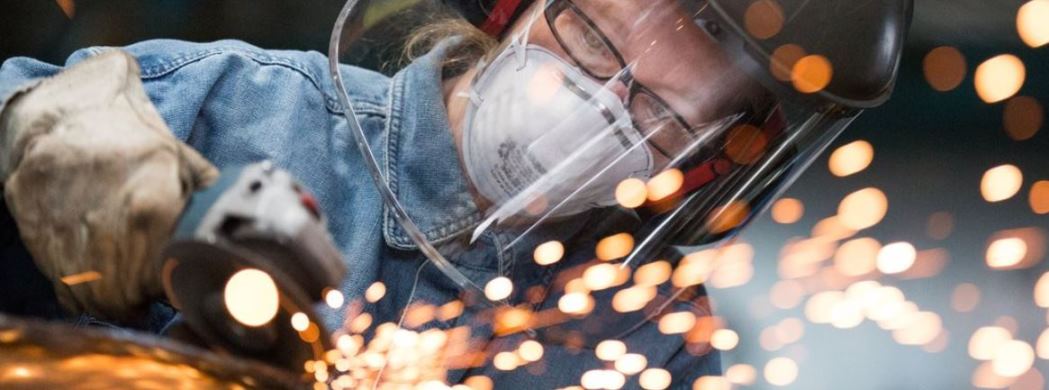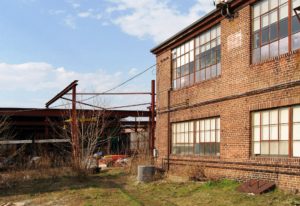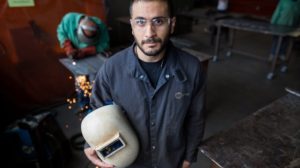The Providence Steel and Iron Company Complex is a historic industrial complex in Providence, Rhode Island. It consists of five one and two-story buildings, built between 1902 and 1951 for the Providence Steel and Iron Company (PS&I), whose corporate lineage begins with the Providence-based Builders Iron Foundry (BIF) in 1822. PS&I continued to operate on the Sims Street property until 2000, when it went out of business.
Now, the site is busy manufacturing again. But today, its product is community revitalization.
Those repurposed and renewed old buildings are churning out a skilled young workforce to boost the local economy, while enlivening the community with arts and public events.
In the years after high school, Anthony Osorio, 28, took all sorts of jobs to pay the bills. “I worked in warehouses, Stop & Shops. Places like that,” recalls the soft-spoken native of Providence, Rhode Island. It wasn’t enough. “I wanted to pick up a skill, a trade,” he says.
On a tip from a friend, in February 2016 Osorio enrolled in a one-week class called Weld to Work at the Steel Yard, a freewheeling arts-based nonprofit in a refurbished former metalworking plant not far from his home on the city’s west side.
During thirty intensive hours Osorio learned to wield the various tools that join, cut, grind, and drill metal. “I fell in love with welding right away,” he says, adding with a laugh, “I liked playing with fire and electricity. It’s awesome.”
Later that year Osorio took on Weld to Work 2.0, a four-week paid crash course in which he helped design and fabricate fencing commissioned for a nearby community garden.
And today? Osorio is an apprentice pipefitter with Union Local 51, on his way to a classic version of the American dream—work that engages hands and mind, making a middle-class wage, with the security of health and pension plans.
Weld to Work, meanwhile, is experiencing its own coming of age. The program began nearly a decade ago as an informal apprenticeship in which novices helped experienced “Yardies” fulfill the Steel Yard’s manufacturing contracts for, say, municipal bike racks or garbage cans.
This year, Weld to Work became an official part of the state’s new workforce development initiative, Real Jobs Rhode Island. Real Jobs links employers in the state with job-training programs; together they tailor worker preparation to fill actual openings and develop the talent local companies require.
The Steel Yard lies in a historic industrial district of Providence surrounded by traditionally working-class neighborhoods hit hard by manufacturing losses of the late twentieth century. Founded as an industrial arts center, it offers studio space and classes in welding, blacksmithing, jewelry and ceramics. As the organization grew, its offerings to the community expanded, too, and today the Steel Yard is, at heart, an arts organization taking a creative approach to workforce development.
LISC, with deep roots in the neighborhood, had been encouraging and occasionally funding Weld to Work for years. “We believed the Weld to Work program had the potential to reach people who might not excel in traditional workforce training programs,” says Jeanne Cola, executive director of LISC Rhode Island.
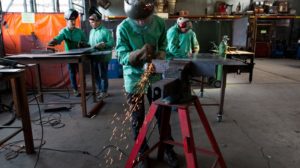 Rhode Island’s manufacturers need employees with complex technical skills, but they’re also looking for new workers with the “soft skills” that will enable them to climb onto the first rung of the industry job ladder as, for example, machine operators or materials handlers. “A lot of what manufacturers are telling me today is that they’re having problems finding people just to show up on time or dress appropriately or who even want to work in manufacturing environments,” says Cowan.
Rhode Island’s manufacturers need employees with complex technical skills, but they’re also looking for new workers with the “soft skills” that will enable them to climb onto the first rung of the industry job ladder as, for example, machine operators or materials handlers. “A lot of what manufacturers are telling me today is that they’re having problems finding people just to show up on time or dress appropriately or who even want to work in manufacturing environments,” says Cowan.
That’s the Steel Yard’s sweet spot. In the wake of the 2008-09 recession, buoyed by federal recovery funds and determined to make the program an instrument of empowerment for local people, the Steel Yard set income eligibility for Weld to Work at the federal poverty line—$24,300 a year for a family of four. It recruits students from a population keenly in need of job opportunities.
Most, like Osorio, have never used industrial tools like the MIG welder or plasma cutter. They learn the calm, quiet comportment necessary to maintain safety in an industrial shop. They get a feel for the teamwork, manual dexterity, and spatial and math skills required to fulfill a real metalworking contract. Nearly all who participate in the invitation-only Weld to Work 2.0 finish the class. They get tips for interviews (“Be very polite!”) and connections to further training and certification.
The Steel Yard’s historic campus is a platform for professional artists, makers and the community to practice and learn the industrial arts.
The organization fosters creative and economic opportunities, by providing workspace, tools, training and education, while forging lasting links to a local tradition of craftsmanship.
The Steel Yard is an award-winning industrial arts center, a manufacturer of custom and functional public-art, a craft school and shared studio, and Providence’s most unique private outdoor venue. its 3.8 acre campus, located in Providence’s Industrial Valley, is a cultural asset that serves as a sponsor and catalyst for innovative approaches to urban revitalization, arts promotion, workforce development, and community growth.
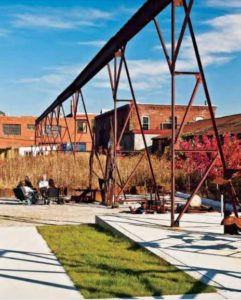 The Steel Yard was founded by Nick Bauta and Clay Rockefeller who purchased the former Providence Steel and Iron complex in 2001 and established it as an industrial arts resource for the community. The founders and earliest members of our community created a place that would serve as a sponsor and catalyst for innovative and positive approaches to urban neighborhood revitalization, arts creation, advocacy and education, workforce development, and community growth.
The Steel Yard was founded by Nick Bauta and Clay Rockefeller who purchased the former Providence Steel and Iron complex in 2001 and established it as an industrial arts resource for the community. The founders and earliest members of our community created a place that would serve as a sponsor and catalyst for innovative and positive approaches to urban neighborhood revitalization, arts creation, advocacy and education, workforce development, and community growth.
They are committed to providing excellent educational programs in the industrial arts and feel that everyone is worthy of access to the knowledge, skills and equipment needed to improve their community. Our professional shared workspaces have equipment for welding, blacksmithing, jewelry, ceramics and the foundry arts.
Since that first weld, thousands of people have come to the Steel Yard’s shop to learn and experience the fire-arts. They are youth, students, professionals, hobbyists and artists, and they share in our vision of a world still made by hand. Together they have built a place where individuals, communities, neighbors, businesses, municipalities and institutions experience the creative process.
The Steel Yard has also become a local manufacturing leader, commissioning more than 250 artists and students to create functional public art projects that are installed throughout the region. This limited line of publicly accessible, street-level art includes decorative bike racks, fences, trashcans, tree guards, and benches for local municipalities.
Yet the Steel Yard has grown to be more than an arts organization; our mission attracts community members to use the site day and night as a hub for learning, working and economic development, to earn a living, place votes in local elections, utilize our open greenspace, attend cultural events, and more.
All photos courtesy of The Steel Yard, unless otherwise credited.

